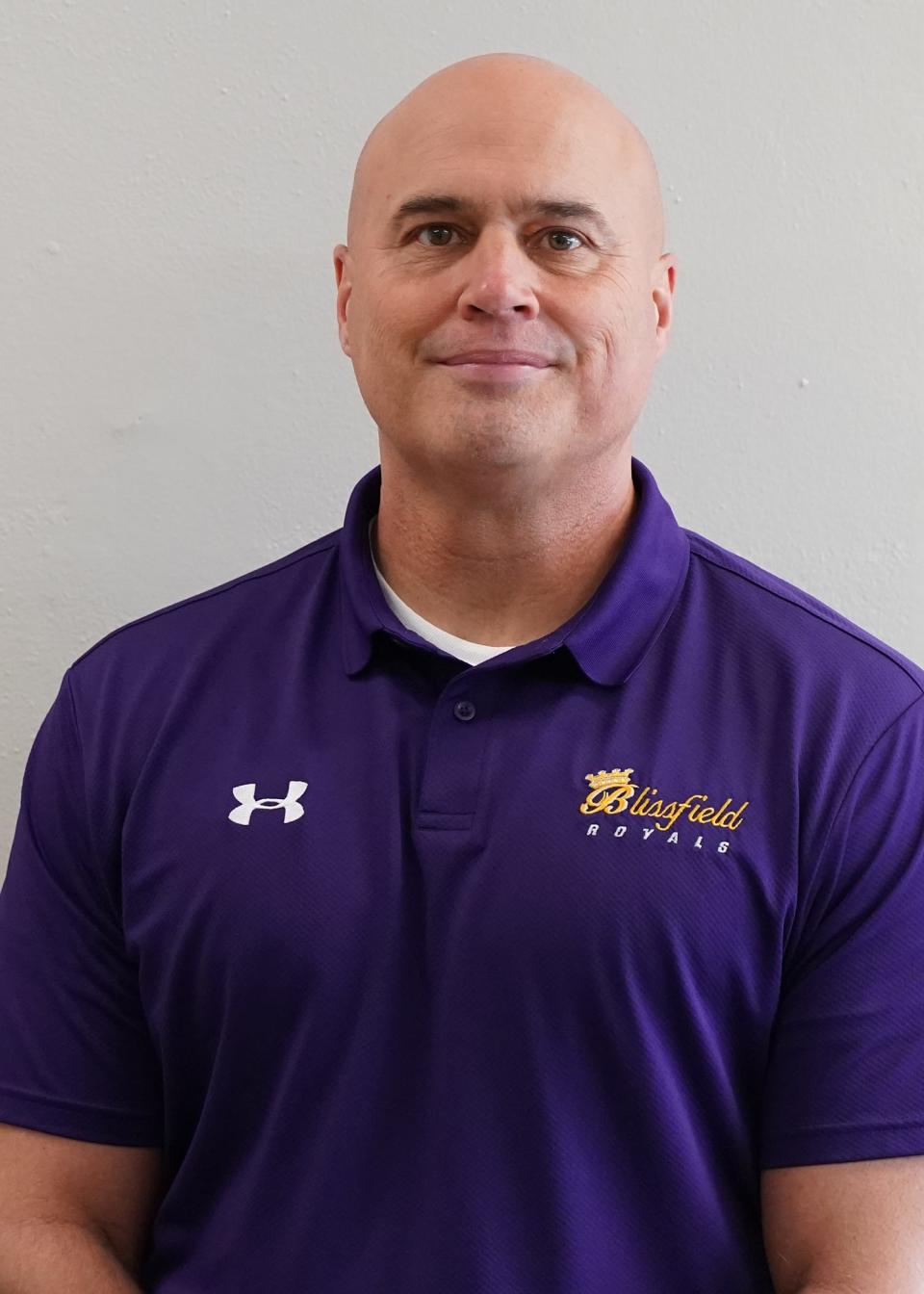Blissfield Community Schools asking voters to approve $23.6 million bond proposal May 2

Editor's note: This story has been corrected to say that Megan Gust, "Yes for BCS" committee member, is a territory manager for Pioneer Hi Bred in Southeast Michigan, which is a seed company.
BLISSFIELD — Blissfield Community Schools has put a 25-year, $23.6 million bond issue on the May 2 special election ballot after a $42 million bond proposal failed with voters last August.
After sending out a survey and gathering feedback at community and sporting events via face-to-face conversations, the district’s school board and administration decided to eliminate the auditorium and the multipurpose additions in the last bond proposal based on feedback.

“The concerns we received back in August of 2022 centered around the total cost (4.8 mills) and the two large additions. We are asking for 3.25 mills, which will generate $23.6 million for the district,” Superintendent Scott Riley said. “All of the items in the bond are critical needs the district has. The three main areas addressed are the learning environment, safety and security, and infrastructure/mechanical.”
Here is a breakdown of what voters are being asked to approve in the May 2 election:

Safety and security
• Secure vestibule entry: Upgrades to the existing building entries. The entry areas would be sectioned off from the remainder of the building with a secure entry vestibule. The vestibule, office area and building hallways would be designed to control visitor access to each facility via electronic door controls and video doorbell systems. The vestibules would have the capability of locking down entry through the vestibule area via duress control buttons.
• Fire alarm system replacement: The fire alarm systems at Blissfield Middle School and Blissfield Elementary School are out of date and in need of replacement. The new systems would allow for improved communication with all building occupants in an emergency.
• Restroom upgrades at the high school to meet American with Disabilities Act requirements.
• Ceiling replacements to abate remaining asbestos to provide safer and healthier learning environments for students and staff.
Educational environment improvements
• Classroom environment upgrades: Classrooms would be updated with new ceilings, LED lighting and mechanical systems improvements. The mechanical systems would be aimed at providing greater student and staff comfort through improved air quality and the addition of air conditioning. New classroom furnishings and technology would allow for greater flexibility in the learning environment.
• Specialty classroom improvements: The bond scope seeks to provide a combination of new amenities for expanded educational opportunities, such as the renovation of space at Blissfield Middle School that would provide an expanded lab for science, technology, engineering and math education. Additions and renovations at Blissfield High School would allow for the expansion of the art room and band room and the renovation of the choir room.
• Space programming flexibility: A proposed cafeteria addition at Blissfield Elementary School would provide dedicated elementary gym space separated from cafeteria space. Currently, the same space serves as both and limits the flexibility of use for elementary physical education due to the meal-time setup and tear-down. The separated spaces would provide greater opportunities for indoor recess activities that would allow students to have physical activity to improve focus when returning to the learning environment. The new space would have the potential to be used for community organization programming and other uses.
• Window additions to middle school classrooms to improve access to daylight.
• Transformation of middle school locker commons area into a learning space (lockers would be relocated throughout the building).
Energy efficiency/operational costs
• Replacement of single-pane windows and exterior doors at the elementary school to improve student and staff comfort and building energy performance.
• Lighting replacement and upgrades to building control systems at the middle and high schools to maximize energy use and efficiency.
There is a community committee called “Yes for BCS” that was formed in May 2022 to support the bond proposal on the Aug. 2, 2022, ballot. Once that proposal failed, the committee stayed intact to support the current proposal. It is made up of community members and parents of Blissfield students.
Megan Gust, "Yes for BCS" committee member, is a territory manager for Pioneer Hi Bred in Southeast Michigan, which is a seed company. She volunteers on a number of committees for the Blissfield school district and spends time volunteering at the elementary school, is one of the volunteers heading up the effort.

For the August 2022 proposal, the committee purchased “Vote Yes for BCS” items including bracelets and water bottles to hand out during community events throughout the summer. Committee members also set up tables at different events to hand out information and are involved in similar activities with this election campaign.
“There have not been any updates to the BCS buildings in 30-plus years. This bond would address crucial needs to ensure a safe, secure and comfortable learning environment for our students and staff. The bond will cover very crucial needs from updating the HVAC systems and adding windows to the middle school to creating secure entrances to all three buildings,” Gust said. “A clean and up-to-date school is something to take pride in as a community. In small towns, the school is the backbone of the community.”
Many school districts in Michigan typically seek approval for bond proposals every five to 10 years for capital improvements to keep district facilities current. Prior to the August 2022 election, the last bond proposal brought to Blissfield Community Schools district voters was a failed election in 2010. The district has never had a successful bond proposal to support facility improvements.
Blissfield schools receives funding from a number of sources. Here is breakdown:
Foundation per-pupil allowance
The state of Michigan provides a per-pupil amount of funding to school districts. Currently, the amount received per pupil is $9,150.
Operational millage (non-homestead tax levy)
This is a voter-approved tax levy that provides operational funding to support the annual school budget. The current non-homestead tax levy in Blissfield is 18 mills, the maximum allowed by state law. It is levied on properties such as businesses, rental properties and vacation homes. The amount collected with this tax is part of total amount the per-pupil funding set by the state.
Staff salaries and benefits account for approximately 80% to 85% of operational millage funding. The remainder is typically used for educational programs, building operation costs and supplies.
Voter-approved sinking funds
These funds provide an annual collection of taxes based on property values. Typically, the collection provides funding for minor facility improvements and renovations. Sinking funds cannot be used for the purchase of buses or furniture.
Blissfield Community Schools currently levies a 1.75-mills sinking fund approved by voters in November 2019. The district is developing plans for these funds. The final determination of use will be based on the outcome of the May 2 election.
Voter-approved bond funds
A bond is a state-approved borrowing process for a set scope of projects. When voters approve a bond proposal, the school district sells bonds in the authorized amount and uses the proceeds of the sale to pay for those projects identified in the bond proposal. Bond proposals are most useful when a district needs a large funding source for facility improvement projects.
In many ways, the bonding process is like a homeowner obtaining a mortgage and making payments over a period of years. The Blissfield Community Schools district currently has no bond debt.
Bond proposal funds cannot be used for employee salaries. They also cannot be used for repair or maintenance costs or other operating expenses. Bond proposal funds must be used only for purposes specified in the ballot language, and, as required by state law, they must be independently audited.
If the bond is approved, Blissfield district residents would pay 5 mills — the sinking fund millage plus the bond millage — compared to Adrian at 5.7 mills, Tecumseh at 3.6 mills, Onsted at 4.05 mills, Clinton at 3.75 mills, Hudson at 3.44 mills and Addison at 2.2 mills.
For a taxpayer with a home value of $100,000 and taxable value of $50,000, the annual cost would be $163. For a taxpayer with a home value of $150,000 and taxable value of $75,000, the annual cost would be $244. And for a taxpayer with a home value of $200,000 and taxable value of $100,000, the annual cost would be $325.
The bonds would be sold in series. A series bond means that voters are asked to approve the overall millage amount once with the May 2 vote, but then bonds to generate project funds would be sold in stages.
The first series would be sold in 2023 and the second series, in 2025. This approach would allow the district to save on interest costs, and would also stagger cashflow for the projects, so it is received when needed due to the potential staggered start and completion dates of the proposed projects.
The millage increase for the first year of the bond was identified at 3.23 mills. Over the life of the bond, it is estimated that the average millage rate needed to expire the bond will be 3.1 mills. The proposed bond term is 25 years.
The polls open at 7 a.m. May 2 and will close at 8 p.m. Residents of Palmyra Township will vote at the Palmrya Township Hall, 6490 Palmyra Road. All other Blissfield Community Schools district residents will vote at the Blissfield Township Fire Department at 299 E. Adrian St. in Blissfield.
Absentee ballot applications can be obtained at the local clerk’s office or by going online to michigan.gov/vote and clicking on "Absentee Voting" in the left column.
Completed absentee ballots must be received by the township clerk by 8 p.m. on Election Day. Residents can submit their absentee ballots by mail or by hand-delivering their ballots to their clerk’s office or their drop box. For those not returning their absentee ballots within two weeks of election day, it is recommended that they hand-deliver their ballots to avoid possible postal delays.
This article originally appeared on The Daily Telegram: Blissfield schools asking voters for $23.6 million bond May 2

 money
money 